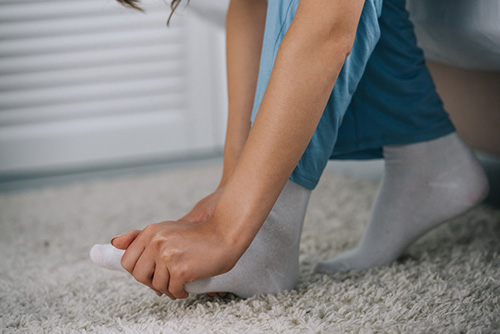So, how do you know if you have plantar fasciitis? Well, pain in the bottom of your heel(s) and/or pain in the arch of the foot is a good indicator, as is pain that’s worse after walking once you’ve been off your feet for a while (like first thing in the morning), or pain that continues to increase over the course of time. However, one of the best things that you can do is visit a foot and ankle surgeon who can both examine and diagnose the cause of your pain. For instance, sometimes heel spurs are found in conjunction with plantar fasciitis and, sometimes, the pain can be caused by something completely different.

Fortunately, there are lots of “first line” treatment strategies that can be accomplished at home. These would include:
Stretching exercises. Exercises that stretch out the calf muscles help ease pain and assist with recovery.
Avoid going barefoot. When you walk without shoes, you put undue strain and stress on your plantar fascia.
Ice. Putting an ice pack on your heel for 20 minutes several times a day helps reduce inflammation. Place a thin towel between the ice and your heel; do not apply ice directly to the skin.
Limit activities. Cut down on extended physical activities to give your heel a rest.
Shoe modifications. Wearing supportive shoes that have good arch support and a slightly raised heel reduces stress on the plantar fascia.
Medications. Oral non-steroidal anti-inflammatory drugs (NSAIDs), such as ibuprofen, may be recommended to reduce pain and inflammation.
If the pain continues to persist, your foot and ankle surgeon may recommend one (or more) of the following:
Padding and strapping. Placing pads in the shoe softens the impact of walking. Strapping helps support the foot and reduce strain on the fascia.
Orthotic devices. Custom orthotic devices that fit into your shoe help correct the underlying structural abnormalities causing the plantar fasciitis.
Injection therapy. In some cases, corticosteroid injections are used to help reduce the inflammation and relieve pain.
Removable walking cast. A removable walking cast may be used to keep your foot immobile for a few weeks to allow it to rest and heal.
Night splint. Wearing a night splint allows you to maintain an extended stretch of the plantar fascia while sleeping. This may help reduce the morning pain experienced by some patients.
Physical therapy. Exercises and other physical therapy measures may be used to help provide relief.
Regardless of the type of treatment that your foot and ankle surgeon prescribes for your plantar fasciitis, you’ll want to continue activities such as wearing supportive shoes and stretching to help prevent a recurrence.
If plantar fasciitis – or any other type of foot and/or ankle issue – is causing you pain, please don’t hesitate to give us a call! Dr. Krejci here at Prairie Orthopaedics and Plastic Surgery, PC is our resident foot and ankle specialist…make an appointment with her, today!
source: foothealthfacts.org

